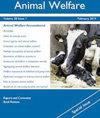实验室饲养的大西洋鲑鱼(Salmo salar)短包膜的评估、原因和后果
IF 2.3
4区 农林科学
Q2 VETERINARY SCIENCES
引用次数: 1
摘要
眼畸形是实验室和其他养殖鱼类常见的形态异常,在各种各样的物种中都有观察到,但病因不明。在对我们实验室饲养的大西洋鲑鱼(Salmo salar)的短盖进行观察后,我们开发了一种摄影键,以1到5的等级对单个鱼进行评分。评级者之间的信度被评估为“几乎完美”。这种直观的方法使用迅速简便,可用于对水箱中的活鱼和取样鱼进行就地评分,不需要复杂的设备,并提供定量信息来调查短包膜的病因。在14个月的时间序列中,随机抽取≥30条鱼(平均体重从0.8 g到299 g)作为样本,对一组室内饲养的大西洋鲑鱼进行眼尺寸评分。短包膜最早记录于幼鱼期,随着鱼的生长,患病率和严重程度增加,畸形不对称,主要发生在左侧。因此,在许多潜在的因果因素中,夹击被认为是我们的培养系统中短包膜的主要原因,由于顺时针电流的不对称性。我们也提出证据表明,短盖与鳃损伤有关,这支持这种畸形是一个值得评估的福利问题。本文章由计算机程序翻译,如有差异,请以英文原文为准。
Assessment, causes and consequences of short opercula in laboratoryreared Atlantic salmon (Salmo salar)
Opercular deformity is a common morphological abnormality of laboratory and other cultured fishes, observed in a wide variety of species but with an unclear aetiology. Following observations of short opercula in stocks of Atlantic salmon (Salmo salar) reared in our laboratory,
we developed a photographic key to score individual fish on a scale of 1 to 5. Inter-rater reliability was assessed as 'almost perfect'. This visual method is quick and simple to use, can be used to score live fish in situ in tanks as well as sampled fish, does not require sophisticated
equipment and provides quantitative information to investigate the aetiology of short opercula. Opercular size was scored for a cohort of in-house reared Atlantic salmon, in a time series of random samples of ≥ 30 fish (mean weights ranging from 0.8 to 299 g) over 14 months. Short opercula
were first recorded during the parr stage, prevalence and severity increased as the fish grew, and the deformity was asymmetrical, occurring predominantly on the left side. Therefore, among the many potential causal factors, nipping is suggested as the primary cause of short opercula within
our culture system, with asymmetry due to the clockwise current. We also present evidence that short opercula are associated with gill damage which supports this deformity being a welfare issue that merits assessment.
求助全文
通过发布文献求助,成功后即可免费获取论文全文。
去求助
来源期刊

Animal Welfare
农林科学-动物学
CiteScore
2.30
自引率
8.30%
发文量
43
审稿时长
18-36 weeks
期刊介绍:
Animal Welfare is an international scientific and technical journal. It publishes the results of peer-reviewed scientific research, technical studies and reviews relating to the welfare of kept animals (eg on farms, in laboratories, zoos and as companions) and of those in the wild whose welfare is compromised by human activities. Papers on related ethical, social, and legal issues and interdisciplinary papers will also be considered for publication. Studies that are derivative or which replicate existing publications will only be considered if they are adequately justified.
Papers will only be considered if they bring new knowledge (for research papers), new perspectives (for reviews) or develop new techniques. Papers must have the potential to improve animal welfare, and the way in which they achieve this, or are likely to do so, must be clearly specified in the section on Animal welfare implications.
 求助内容:
求助内容: 应助结果提醒方式:
应助结果提醒方式:


